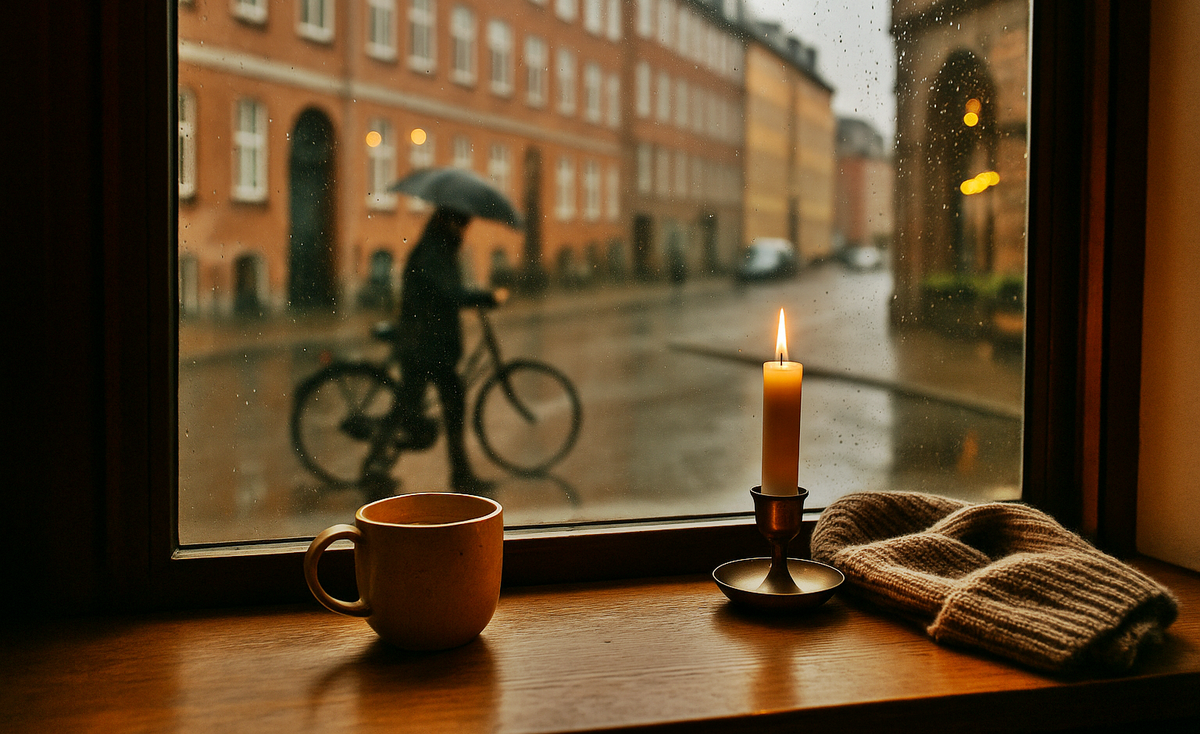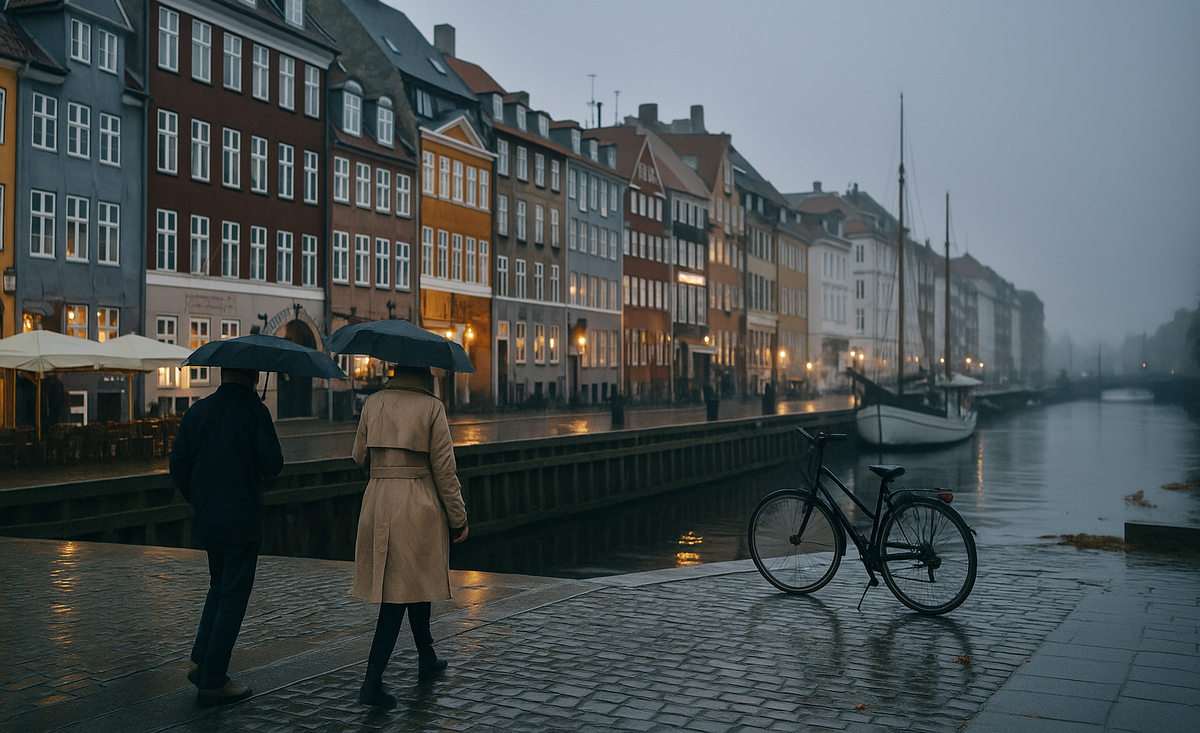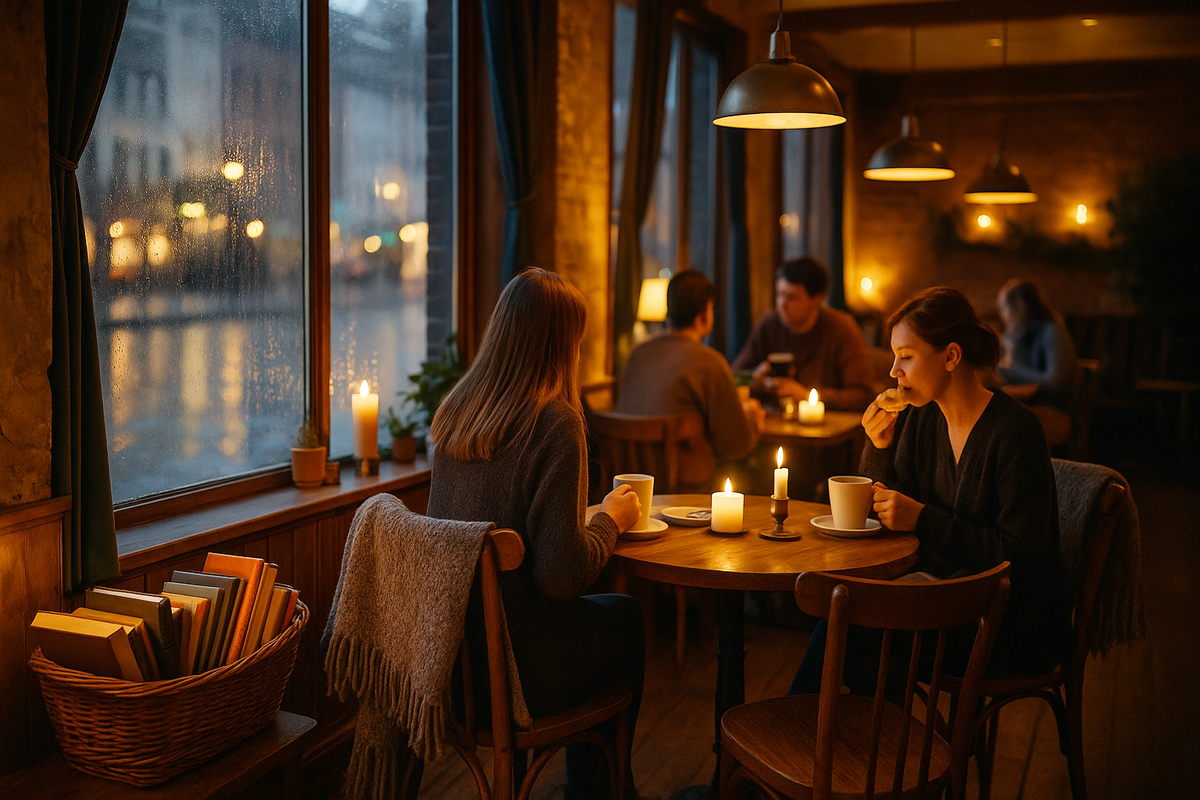🍁 November in Denmark: going for hygge? 2–3 days without crowds and how not to get bored
November in Denmark is not a postcard with snow and fairs, but an honest transition to winter: it's cool, damp, it gets dark early, and there are few tourists. The temperature stays around 3–8 °C, with high humidity and wind, it feels noticeably colder than the thermometer shows. On the other hand, it is the low season: demand decreases, accommodation prices fall, and museums and attractions operate without the summer crowds, so you can ‘catch the winter charm without the crowds’. At the same time, hygge intensifies: candles in cafés, warm light in windows and cosy interiors turn the early darkness into an opportunity to gather inside for coffee and buns.

🌧️ Weather, daylight hours and the feel of the city in November
⛅ Temperature and humidity
According to climate statistics, the average temperature in Copenhagen in November is around 5 °C, with daytime values around 6–7 °C and nighttime values around 3 °C. Precipitation is approximately 40–50 mm per month, with rainy days accounting for up to half of the calendar.
Due to the wind and humidity, these ‘modest +5’ easily feel like zero: without layers and waterproof shoes, it is very easy to get cold. It is not freezing, but ‘walking for a long time without a plan B to go indoors’ is already uncomfortable.
🕓 Daylight hours: when to get everything important done
In November, the days become noticeably shorter: on average, there are about 8–8.5 hours of daylight. In the middle of the month, sunrise is around 7:40 a.m. and sunset is around 4:00 p.m., and by the end of the month, it is even earlier.
In practical terms, this means:
- after 3:00–3:30 p.m., it starts to get dark,
- so it's best to plan everything you want to see and photograph outdoors between 10:00 a.m. and 3:00 p.m.
- Evening is the time for lights, shop windows, cafés and bars.
🧣 Clothing and the mood of the city
The standard outfit for Copenhagen in November includes:
- thermal underwear or a warm base layer,
- a jumper/fleece,
- windproof and waterproof outerwear,
- a hat, scarf, gloves, and waterproof shoes.
The mood of the city at this time is often described as ‘a city in a warm jumper’: fewer people on the streets and tourist routes, more life in cafés, patisseries, bars, museums and galleries. Autumn in Copenhagen is directly referred to as the time for hygge and indoor activities.
💰 Crowds and prices: why November is a good time to visit (and where the catch is)

👥 Fewer people — more space
November is officially considered the off-season: the main tourist flows have already left after autumn and have not yet arrived for the Christmas markets. Many guides refer to January, February and November as the ‘low season’ when hotels are empty and museums are less crowded.
The result for travellers:
- queues at top museums are minimal,
- it is easier to find a table in popular cafés and restaurants,
- and the city feels more local than touristy.
💸 Prices and differences from December
November is more favourable than December:
- according to travel guides, accommodation prices in November are among the lowest of the year,
- while in December, Copenhagen becomes significantly more expensive due to the Christmas rush, fairs and short city breaks.
To put it simply, the picture looks like this:
| Month | Crowds 👥 | Accommodation prices 💶 | Atmosphere 🎭 |
|---|---|---|---|
| July | Maximum | High | Summer, street life, festivals |
| November | Low/Moderate | Below average | Hygge, cafés, museums, lights |
| December | High (peak) | High/very high | Markets, Christmas, crowds |
The catch is that part of the ‘fairytale’ Christmas atmosphere is not yet in place (especially in the first half of the month), and the weather already feels like winter. If you are going for the picture-perfect fairs, it is best to check the specific dates when the lights and markets will be turned on in your year.
🗺️ What to do in 2–3 days: a ‘warm’ itinerary without boredom

The key idea for November: during the day — a compact block of streets and culture, in the evening — lights and hygge inside.
📆 Option for 2 days
☕ Day 1: city centre, museums and evening lights
Day (10:00–16:00):
- A large museum block of your choice:
- National Museum,
- Carlsberg Glyptotek,
- SMK (National Gallery).
- Snacks and coffee in covered markets and bakeries (Torvehallerne and small bakeries are ideal on a rainy day).
Evening (after 16:00):
- Walk through the centre and along Nyhavn: in November, some of the garlands and lights may already be up, especially in the second half of the month.
- Window shopping, the first elements of winter decor, photos in the light of the lanterns.
- Finish with dinner in a cosy restaurant or bistro with an emphasis on comfort food.
🐠 Day 2: large indoor attraction + hygge
Day:
- Large indoor activity:
- the museum of modern art by the sea,
- the design museum,
- the Den Blå Planet aquarium — ‘lots inside, few views outside’ format.
- Return to the city — a short walk around the area where you live.
Evening:
- Café hopping: 1–2 coffee shops/pastry shops where you can sit for a long time, read, work or just chat.
- A bar with quiet jazz, a wine bar or craft beer — the perfect November mood. 🎷
📆 Option for 3 days
There are several ways to spend the third day:
- Castles and history:
- Rosenborg + Christiansborg,
- changing of the guard, views from the tower, walks in the surrounding parks.
- Short trip:
- Roskilde: cathedral, Viking museum, waterfront (weather permitting).
- A pure hygge day:
- a long breakfast in a café,
- sauna/bathing or spa,
- bookshops, design shops, small galleries,
- an evening in a ‘candlelit’ restaurant or bar.
📌 It's handy to keep a simple matrix in mind:
| Day | Daytime 🔍 | Evening 🕯 |
|---|---|---|
| 1 | City centre + major museum | Nyhavn lights, dinner, wine bar |
| 2 | Aquarium/design/art | Coffee shops, bar, jazz |
| 3 | Castles / day trip / “lazy” hygge | Long dinner, candles, conversations |
The main thing is not to spread yourself too thin: the day is short, and the weather is not conducive to a marathon across seven locations, but rather to two or three quality blocks per day.
🧣 Hygge mindset: how to turn darkness and dampness into a plus

November is the perfect month to experience Denmark through hygge rather than a checklist of sights.
🍰 Where to find hygge
Types of places to include in your itinerary:
- Pastry shops and bakeries with long tables and soft lighting: cinnamon rolls, puff pastries, filter coffee, cocoa.
- Candlelit cafes and wine bars: lots of wood, textiles, candles on the tables, a feeling of ‘we're here for a long time’.
- Book and design shops: ideal for rainy days — a combination of visual pleasure and warmth.
- Small concerts and jazz venues: intimate halls, live sound, a glass of wine — something that November enhances many times over.
Many sources directly refer to autumn and early winter in Copenhagen as the peak of hygge culture: it gets dark early, people ‘move indoors,’ and the city plays with the light of windows and candles.
🧠 Mood: don't argue with the darkness
The key to a comfortable November is not to try to live according to the June scenario.
- Accept that it's already dark at 4 p.m. and use this as an excuse to have another evening indoors, rather than as a loss of the day.
- Consider cafes, bars and museums not as a backup plan, but as an integral part of your itinerary.
- Pace yourself outdoors: walk → warm up → walk, rather than ‘five hours straight in the wind’.
✅ Mistakes, life hacks and conclusion: who should go in November
⚠️ Typical mistakes
- 🧊 Expecting a ‘Christmas fairy tale’: in the first half of November, full-fledged fairs and decorations may not be up and running yet or may be in preparation mode. December is a different price tag and different crowds.
- 🌑 Ignoring the short days: scheduling your main walks and photo shoots for after 4 p.m. and then being disappointed that you ‘didn't get to see anything in the light.’
- 🥶 Underestimating the dampness and wind: focusing only on the ‘+5 in the forecast’ and arriving in a light coat and trainers without waterproofing. Reality quickly corrects expectations.
💡Life hacks for a November trip
- 📅 Focus your activities between 10:00 and 16:00 — museums + short walks around the neighbourhood. Everything else — lights, windows, cafes.
- 🏨 Choose weekdays: on working days, both accommodation and tickets are often cheaper, and the city is a little quieter than on weekends.
- 🎄 If lights and fairs are important to you, check in advance when the decorations, Christmas markets and winter season at Tivoli start this year.
🎯 Who November is really suitable for
November is ‘your’ month if you:
- love quiet cities without crowds,
- appreciate cafes, museums, books, design and cosiness more than beaches and endless streets,
- want to save money on accommodation and flights, but still catch the lights, early winter cosiness and the atmosphere of a big northern city,
- are ready to accept darkness and weather as part of the experience, not as a planning mistake.
If you want to enjoy street life to the fullest and have long days, you should consider May to September. But for a short, intimate, ‘candlelit’ city break of 2-3 days, November in Denmark is a very conscious and practical choice.
FAQ
💡Yes, if you're not going for the beaches and long days, but for the cosiness and atmosphere. November means fewer tourists, lower prices, quiet museums and maximum hygge in cafés, bars and bookshops, provided you are prepared for short days and wet weather.
💡Visit the major museums and galleries during the day, combine them with markets and bakeries, and in the evening go to cafés, wine bars, small concerts and walks through the illuminated city centre and along the embankment. If you wish, you can add one trip — to a castle, a museum of modern art or a neighbouring town.
💡On average, yes: November is considered the low season, when demand for hotels and flights is significantly lower than in summer and during the Christmas period. In December, prices jump due to fairs and pre-New Year trips, while November remains a ‘quiet corridor’ with more comfortable prices and no crowds.
💡The thermometer usually reads 3–8 °C, but the wind and humidity make it feel colder. You will need layers (thermal underwear/T-shirt + jumper/fleece + windproof jacket), waterproof shoes, a hat, scarf and gloves — then both walks and evening trips between cafés will be comfortable.
💡 Those who love quiet cities without crowds, appreciate cafes, museums, books and design more than beaches and festivals, want to save money and are willing to accept early darkness and dampness as part of the experience. If your ideal trip is ‘museums during the day, candles and coffee in the evening,’ November is a very good choice.





0 comments
Log in to leave a comment